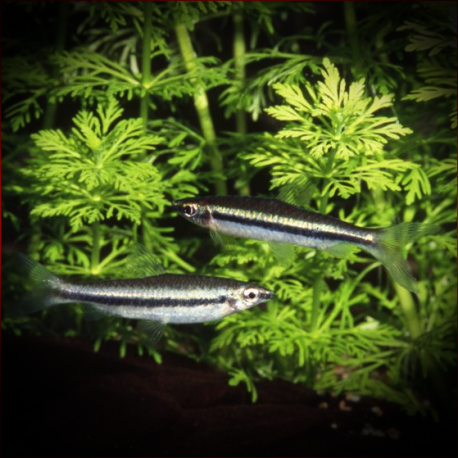More info
Datasheet
| Minimum Tank Size | 60 litres / 15.85 US gallons |
| Maximum Size | 4.6cm / 1.81inches |
| Temperature | 22°C / 71.60°F - 28°C / 82.40°F |
| Hardness | 1.01dgH / 18ppm - 12.05dgH / 215ppm |
| pH | 5.0-7.0 |
General Description
Nannostomus Grandis, a member of the Lebiasinidae family, is a species that is relatively unknown in the aquarium trade but is occasionally exported alongside other species, notably the Nannostomus beckfordi. It is distinguishable by its lack of pale white or bluish tips on the ventral fins, along with specific physical characteristics such as body size, head size, and fin features. This species can reach up to 4.6 cm in length and has a slender body shape.
Aquarium Setup
For optimal care, Nannostomus Grandis thrives in a heavily planted tank with a dark substrate to mimic its natural habitat. The presence of floating plants, driftwood branches, and dried leaf litter is beneficial as they provide hiding spots and stimulate microorganism growth. A gentle filtration system is recommended, while water conditions should range between a pH of 5.0-7.0, hardness of 18-215ppm, and a temperature of 22-28°C.
Behaviour
As a peaceful species, Nannostomus Grandis is best housed with similarly-sized and calm tank mates. It can coexist with small characids, catfish, and dwarf cichlids. In community setups, it can be paired with rasboras, barbs, and other peaceful fish. Keeping Nannostomus Grandis in groups of 10 or more reduces aggression among individuals and encourages more natural behavior.
Feeding and Diet
In their natural habitat, Nannostomus Grandis primarily feeds on tiny invertebrates and zooplankton. In captivity, they readily accept small live and frozen foods like Artemia nauplii and Moina, in addition to appropriately sized dried foods. Offering a varied diet ensures their nutritional needs are met and encourages overall health.
Reproduction & Dimorphism
Details regarding the reproductive behavior of Nannostomus Grandis are currently unreported. Mature females are expected to have a stockier appearance compared to males, although other distinguishing characteristics remain unverified.
Habitat and Distribution
While precise distribution data is limited, Nannostomus Grandis originates from Belém, Pará state, in eastern Brazil. Similar species are found in sluggish tributaries, small rivers, and areas rich in aquatic vegetation, submerged woody structures, and leaf litter, indicating a preference for habitats with ample cover and natural hiding places.

